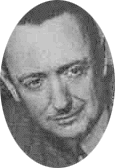 John Dickson Carr (1906 -
1977) was born in Uniontown, Pa. as the son of Julia and Wooda Nicholas Carr, a
Pennsylvania lawyer who served a term in Congress. Carr told a story of himself as a child
being introduced to President Woodrow Wilson and asking him what he did for a living. John Dickson Carr (1906 -
1977) was born in Uniontown, Pa. as the son of Julia and Wooda Nicholas Carr, a
Pennsylvania lawyer who served a term in Congress. Carr told a story of himself as a child
being introduced to President Woodrow Wilson and asking him what he did for a living.
Settling in England, Carr attained a pace of four novels a year, plus radio and short
story work. It was more than one publisher could handle, so Carr started with another
publisher, choosing the pseudonym Nicholas Wood in honor of his father. When The
Bowstring Murders (1933) appeared, it bore, to his shock, the byline "Carr
Dickson." Both Carr and the original publisher were understandably miffed, but a
slight change to "Carter Dickson" mollified them. The
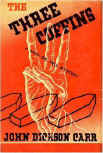 dual identity was one of
the worst-kept secrets in the history of the genre, with stories appearing under either
name in various collections. Carr was elected to the Detection Club, the first American to
be so honored. Carr is best known for his intricate puzzle novels with strong Gothic and supernatural
overtones. The man is known as "the master of the locked room." He was that. No
one in the history of the genre could match him for sheer sustained ingenuity when it came
to devising reader-bamboozling locked rooms and other impossible crimes. Of these, The Three Coffins
(1935), contains not only a
mystery, but a lecture by Dr. Fell which defines the genre. He was also author of the
first standard
dual identity was one of
the worst-kept secrets in the history of the genre, with stories appearing under either
name in various collections. Carr was elected to the Detection Club, the first American to
be so honored. Carr is best known for his intricate puzzle novels with strong Gothic and supernatural
overtones. The man is known as "the master of the locked room." He was that. No
one in the history of the genre could match him for sheer sustained ingenuity when it came
to devising reader-bamboozling locked rooms and other impossible crimes. Of these, The Three Coffins
(1935), contains not only a
mystery, but a lecture by Dr. Fell which defines the genre. He was also author of the
first standard
 biography of Sir Arthur Canon Doyle
(1949), and collaborated with Doyle's
son Adrian in The Exploits of Sherlock Holmes biography of Sir Arthur Canon Doyle
(1949), and collaborated with Doyle's
son Adrian in The Exploits of Sherlock Holmes
 (1954). Incidentally, he showed himself also to be a master at putting one over on the
publisher. In 1964, ill and behind schedule, yet still required to submit a book, he
dusted off the thirty-year-old Devil Kinsmere, revised it, retitled it Most
Secret, and had it accepted again by the publishing company that issued it
unsuccessfully thirty years before. From 1969 until his death, he wrote "The
Jury Box," a mystery review column in EQMM. Carr created four distinct, and distinctly likable detectives: Henri Bencolin and Dr.
Gideon Fell under his own name, and Sir Henry Merrivale and Colonel March as Dickson. What
is even more remarkable is that they remain distinguishable even though they all meet the
same type of cases (impossible crimes) and tend to serve the same function in the
structure of the story.
(1954). Incidentally, he showed himself also to be a master at putting one over on the
publisher. In 1964, ill and behind schedule, yet still required to submit a book, he
dusted off the thirty-year-old Devil Kinsmere, revised it, retitled it Most
Secret, and had it accepted again by the publishing company that issued it
unsuccessfully thirty years before. From 1969 until his death, he wrote "The
Jury Box," a mystery review column in EQMM. Carr created four distinct, and distinctly likable detectives: Henri Bencolin and Dr.
Gideon Fell under his own name, and Sir Henry Merrivale and Colonel March as Dickson. What
is even more remarkable is that they remain distinguishable even though they all meet the
same type of cases (impossible crimes) and tend to serve the same function in the
structure of the story.
Carr did not attempt to write stories of genteel murders solved by detached intellectuals.
Carr, who frequently used the phrase "improving one's mind with the study of
sensational fiction," would wade hip-deep in atmosphere. Ruined castles, rats, rooms
that seem to kill, and lurid tales from the plague era all figure in his novels. There are
often pools of blood. On top of this, Carr could write scenes of rollicking slapstick and
frequently threw them in the same books with the brooding horrors, thereby somehow
increasing the impact of both. To quote a contemporary assessment from Dorothy L. Sayers,
"In short, he can write."
  Francis M(ichael), Jr. Nevins
(Bayonne, New Jersey, Jan 6. 1943 -
) U.S. lawyer, law professor, editor, anthologist, and scholar and writer of
mystery stories. He teaches Estates, Copyright, Law and Electronic Media, and seminars in
related areas at the St. Louis University Law School in Missouri. An scholar
of the genre who constantly unearths great old stories and reintroduces forgotten writers
to modern scrutiny. Prof. Nevins is an accomplished mystery writer, having published
numerous short stories and five full-length mystery novels. Some book-length
critical works by Nevins, both of which have won Edgar Awards are Royal Bloodline:
Ellery Queen, Author and Detective won for 1974, and the study Cornell
Woolrich: First You Dream, Then You Die was the best critical/biographical work of
1988. Francis M(ichael), Jr. Nevins
(Bayonne, New Jersey, Jan 6. 1943 -
) U.S. lawyer, law professor, editor, anthologist, and scholar and writer of
mystery stories. He teaches Estates, Copyright, Law and Electronic Media, and seminars in
related areas at the St. Louis University Law School in Missouri. An scholar
of the genre who constantly unearths great old stories and reintroduces forgotten writers
to modern scrutiny. Prof. Nevins is an accomplished mystery writer, having published
numerous short stories and five full-length mystery novels. Some book-length
critical works by Nevins, both of which have won Edgar Awards are Royal Bloodline:
Ellery Queen, Author and Detective won for 1974, and the study Cornell
Woolrich: First You Dream, Then You Die was the best critical/biographical work of
1988.
In 2002 (together with Martin Grams, Jr) he wrote
The Sound of Detection: Ellery Queen’s Adventures in Radio
which updated the information from an earlier
1973 edition (with Ray Stanich).
Read More Here...
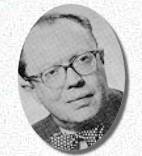 Anthony Boucher
(Augt 21. 1911 - April
29. 1968) William Anthony Parker White, to give him his full name, was well-known in both SF
and detection circles. He was born in Oakland, California and until his death in 1968
spent most of his working days as an author, editor and critic of these two genres plus --
another major interest -- opera and music. Thus he regularly reviewed detective stories
for EQMM. Anthony Boucher also edited True Crime Detective magazine
(1952 - 1953), half a dozen detection anthologies and, in succession, three major American
lines of crime fiction: the Mercury Mysteries (1952 - 1955), the Dell Great Mystery Library
(1957 - 1960) and the Collier Mystery Classics
(1962 - 1968). Between 1945 and 1948 he wrote radio
plays for the Sherlock Holmes and Case Book of Gregory Hood (with Denis
Green) series in the USA. He even stepped as replacement for Frederic Dannay to continue
the Ellery Queen radio drama together with Manfred B.Lee. The Mystery Writers of America
elected him their President for 1951, and three times voted him the Edgar Allan Poe award
for excellence in criticism (1946, 1950, 1953). In 1970, after his death, American
detective fans began annual conventions in his memory -- "Bouchercons". Another
nonfiction book, published during his lifetime, was
Ellery Queen: A
Double Profile (1951); this of course dealt with the two authors who between them were
the late Ellery Queen. His fictional output wasn't huge. Apart from the
multiple collaboration The Marble Forest (1951, as by "Theo Durrant",
also known as The Big Fear), it consists of seven detective novels and barely fifty
short stories, some mysteries, some SF/fantasy and some an enjoyable mixture of both. He
died of lung cancer. Anthony Boucher
(Augt 21. 1911 - April
29. 1968) William Anthony Parker White, to give him his full name, was well-known in both SF
and detection circles. He was born in Oakland, California and until his death in 1968
spent most of his working days as an author, editor and critic of these two genres plus --
another major interest -- opera and music. Thus he regularly reviewed detective stories
for EQMM. Anthony Boucher also edited True Crime Detective magazine
(1952 - 1953), half a dozen detection anthologies and, in succession, three major American
lines of crime fiction: the Mercury Mysteries (1952 - 1955), the Dell Great Mystery Library
(1957 - 1960) and the Collier Mystery Classics
(1962 - 1968). Between 1945 and 1948 he wrote radio
plays for the Sherlock Holmes and Case Book of Gregory Hood (with Denis
Green) series in the USA. He even stepped as replacement for Frederic Dannay to continue
the Ellery Queen radio drama together with Manfred B.Lee. The Mystery Writers of America
elected him their President for 1951, and three times voted him the Edgar Allan Poe award
for excellence in criticism (1946, 1950, 1953). In 1970, after his death, American
detective fans began annual conventions in his memory -- "Bouchercons". Another
nonfiction book, published during his lifetime, was
Ellery Queen: A
Double Profile (1951); this of course dealt with the two authors who between them were
the late Ellery Queen. His fictional output wasn't huge. Apart from the
multiple collaboration The Marble Forest (1951, as by "Theo Durrant",
also known as The Big Fear), it consists of seven detective novels and barely fifty
short stories, some mysteries, some SF/fantasy and some an enjoyable mixture of both. He
died of lung cancer.
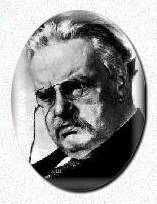 G.K. Chesterton
(May 29. 1874 - Jun 14. 1936), Gilbert Keith Chesterton was a versatile and
iconoclastic English author equally at home in many genres. He wrote novels
(1904),
criticism (works on Robert Browning, Charles Dickens, and George Bernard Shaw), poetry,
biography (St. Francis of Assisi, St. Thomas Aquinas), and innumerable essays. He was also
a talented artist, as seen in his boisterous illustrations of his own works. Among his
admirable short stories, the best known are those about the priest-detective Father Brown,
who first appeared in The Innocence of Father Brown
(1911) and continued through
five collections. Father Brown's methods were based less on material clues than on his
intuitive knowledge of human motivation. The plots are unlikely but the puzzles ingenious,
and the superbly written stories abound in the illuminating paradoxes of which Chesterton
was a master and in breathtaking analyses of moral truth. A doctrinal and social
conservative, Chesterton was received into the Roman Catholic church in 1922 by his friend
Father John O'Connor (the model for Father Brown), and exercised a considerable influence
on later English Catholic writers, notably Evelyn Waugh. Ever the individualist, he was
known for his ebullient humor and huge girth. In 1936 he published his autobiography. G.K. Chesterton
(May 29. 1874 - Jun 14. 1936), Gilbert Keith Chesterton was a versatile and
iconoclastic English author equally at home in many genres. He wrote novels
(1904),
criticism (works on Robert Browning, Charles Dickens, and George Bernard Shaw), poetry,
biography (St. Francis of Assisi, St. Thomas Aquinas), and innumerable essays. He was also
a talented artist, as seen in his boisterous illustrations of his own works. Among his
admirable short stories, the best known are those about the priest-detective Father Brown,
who first appeared in The Innocence of Father Brown
(1911) and continued through
five collections. Father Brown's methods were based less on material clues than on his
intuitive knowledge of human motivation. The plots are unlikely but the puzzles ingenious,
and the superbly written stories abound in the illuminating paradoxes of which Chesterton
was a master and in breathtaking analyses of moral truth. A doctrinal and social
conservative, Chesterton was received into the Roman Catholic church in 1922 by his friend
Father John O'Connor (the model for Father Brown), and exercised a considerable influence
on later English Catholic writers, notably Evelyn Waugh. Ever the individualist, he was
known for his ebullient humor and huge girth. In 1936 he published his autobiography.
|



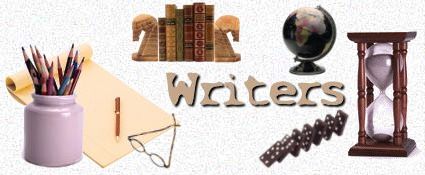
![]()
 John Dickson Carr (1906 -
1977) was born in Uniontown, Pa. as the son of Julia and Wooda Nicholas Carr, a
Pennsylvania lawyer who served a term in Congress. Carr told a story of himself as a child
being introduced to President Woodrow Wilson and asking him what he did for a living.
John Dickson Carr (1906 -
1977) was born in Uniontown, Pa. as the son of Julia and Wooda Nicholas Carr, a
Pennsylvania lawyer who served a term in Congress. Carr told a story of himself as a child
being introduced to President Woodrow Wilson and asking him what he did for a living.
 dual identity was one of
the worst-kept secrets in the history of the genre, with stories appearing under either
name in various collections. Carr was elected to the Detection Club, the first American to
be so honored. Carr is best known for his intricate puzzle novels with strong Gothic and supernatural
overtones. The man is known as "the master of the locked room." He was that. No
one in the history of the genre could match him for sheer sustained ingenuity when it came
to devising reader-bamboozling locked rooms and other impossible crimes. Of these, The Three Coffins
(1935), contains not only a
mystery, but a lecture by Dr. Fell which defines the genre. He was also author of the
first standard
dual identity was one of
the worst-kept secrets in the history of the genre, with stories appearing under either
name in various collections. Carr was elected to the Detection Club, the first American to
be so honored. Carr is best known for his intricate puzzle novels with strong Gothic and supernatural
overtones. The man is known as "the master of the locked room." He was that. No
one in the history of the genre could match him for sheer sustained ingenuity when it came
to devising reader-bamboozling locked rooms and other impossible crimes. Of these, The Three Coffins
(1935), contains not only a
mystery, but a lecture by Dr. Fell which defines the genre. He was also author of the
first standard
 biography of Sir Arthur Canon Doyle
(1949), and collaborated with Doyle's
son Adrian in The Exploits of Sherlock Holmes
biography of Sir Arthur Canon Doyle
(1949), and collaborated with Doyle's
son Adrian in The Exploits of Sherlock Holmes
 (1954). Incidentally, he showed himself also to be a master at putting one over on the
publisher. In 1964, ill and behind schedule, yet still required to submit a book, he
dusted off the thirty-year-old Devil Kinsmere, revised it, retitled it Most
Secret, and had it accepted again by the publishing company that issued it
unsuccessfully thirty years before. From 1969 until his death, he wrote "The
Jury Box," a mystery review column in EQMM. Carr created four distinct, and distinctly likable detectives: Henri Bencolin and Dr.
Gideon Fell under his own name, and Sir Henry Merrivale and Colonel March as Dickson. What
is even more remarkable is that they remain distinguishable even though they all meet the
same type of cases (impossible crimes) and tend to serve the same function in the
structure of the story.
(1954). Incidentally, he showed himself also to be a master at putting one over on the
publisher. In 1964, ill and behind schedule, yet still required to submit a book, he
dusted off the thirty-year-old Devil Kinsmere, revised it, retitled it Most
Secret, and had it accepted again by the publishing company that issued it
unsuccessfully thirty years before. From 1969 until his death, he wrote "The
Jury Box," a mystery review column in EQMM. Carr created four distinct, and distinctly likable detectives: Henri Bencolin and Dr.
Gideon Fell under his own name, and Sir Henry Merrivale and Colonel March as Dickson. What
is even more remarkable is that they remain distinguishable even though they all meet the
same type of cases (impossible crimes) and tend to serve the same function in the
structure of the story.
